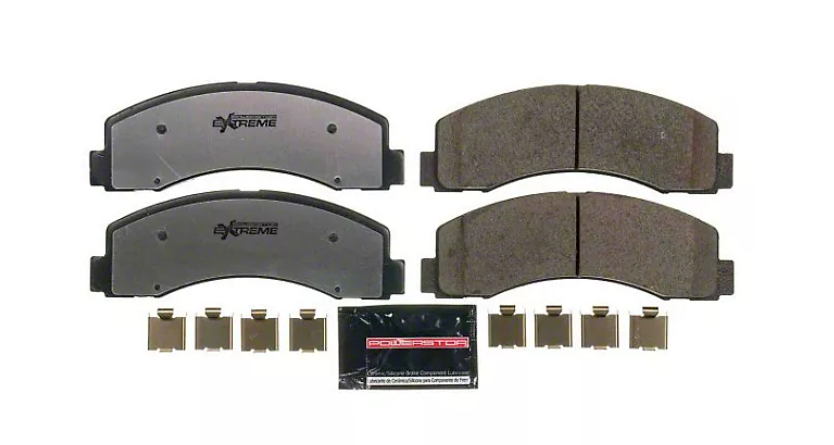
What Are The Best Brake Pads in 2020: Ceramic or Semi-Metallic?

It’s the ultimate question when it comes to replacing your brakes: “What are the best brake pads for my car?” You want performance. You want to stop on a dime. You want quiet braking. Is that so complicated? Yes and no. The first thing you need to decide is whether you’re looking for ceramic vs. semi-metallic brake pads. But while both semi-metallic brake pads and ceramic brake pads (or any brakes, for that matter) serve the same essential function, there are a lot of differences between them. And the best brake pads for your car depend not only on the pads, but on you.
Braking is a tradeoff. A brake pad that works well driving around the city isn’t suitable for the racetrack, just like a dedicated race pad won’t function adequately on the street. A pad that’s quieter may also be less durable. You can compare semi-metallic vs ceramic brake pads for 10 different cars and never come to the same conclusion. That’s simply because there will never be one “best” brake pad for every vehicle, every driver and every situation. Driving demands, individual preferences and your own unique style of hitting the brakes all factor into which brake pads are the best for your car or truck. But that’s why we’re here to help. Our team of experts have broken down the best brake pads on the market—as well as the pros and cons of each type. Ceramic brakes, organic brakes, semi-metallic brakes—they all have their place. Read on to figure out the best brake pads for you.
The Evolution of Brake Pads
Let’s start some quick and painless brake pad history. When disc brakes—which use calipers to squeeze pads on either side of a wheel’s rotor—started to go mainstream in the 1950s and ’60s, asbestos was the preferred brake-pad material. Asbestos is heat resistant, durable, effective, and relatively cheap. As everyone now knows, it’s also bad for your health. As the hazards of asbestos became more widely known, the pads fell out of favor and manufacturers had to go looking for alternatives that would perform without breaking the bank. They came up with three categories of pads: organic, semi-metallic, and organic.
Organic Brake Pads
Organic brake pads (also known as NAO, or “non-asbestos organic”) are composed of various materials—like glass, fiber, rubber, carbon and Kevlar—mixed with binding resins that hold them together. The materials and tools used to manufacture organic brake pads are still the least expensive, which is why about 70% of new cars sold in the U.S. come factory-fitted with organic brakes.
Pros:
- Soft, quiet, easy on brake rotors
- Don’t require much heat to generate good friction
- Produce less dust than semi-metallic brake pads
- Low manufacturing cost
- Suitable for normal driving/commuting across many environments
- Perfect for every day vehicles and drivers
Cons:
- Only operate well within a relatively limited temperature range
- Wear out quickly compared to other types of brake pads
- High compressibility—can cause “mushy” brake pedal-feel
- When overheated, they lose some of their braking power
- Not at all suitable for performance driving
While they do get the job done, most drivers are left with a feeling of “meh” when they look at everything organic brakes have to offer—especially those looking to do performance driving. Most people who want to upgrade their braking system will turn to ceramic or semi-metallic brake pads.
Semi-metallic brake pads
Semi-metallic pads contain 30-65% metal by weight, typically consisting of steel, iron, copper, etc. Manufacturers combine metal fibers with friction modifiers and fillers, as well as a graphite lubricant. High-quality semi-metallic brake pads will have finer metallic fibers and lower-quality ones will be more coarse. Regardless of the thickness of the fibers in your semi-metallic brake pads, a noticeable advantage they have is the ability of the metallic composition to draw heat away from the rotor, giving you more efficient brake-cooling.
Pros:
- Dramatically better braking performance than organic pads
- Perform well in a wide range of temperatures
- Less resistant to wear across temperatures (aka, higher thermal threshold)
- Good cold bite—they perform well from the outset, without being warmed up
- Provide a firmer brake pedal feel (low compressibility)
- Much more resistant to brake fade than organic pads
- Numerous compounds available—suitable for anything, from daily street-driving to extreme track use
Cons:
- Tend to be noisier than organic or ceramic brake pads
- Produce more brake dust
- More abrasive than other types of pads—which you can expect to wear brake rotors more quickly
- More expensive than organic pads (but generally cheaper than ceramic brakes)
- Require careful and proper bedding-in for the best performance
Though we certainly can’t say that semi-metallics are the best brake pads across the board, they are extremely versatile. They’re a little more expensive but a lot higher-performing than organic pads. Still, if you’re comparing semi-metallic vs ceramic, there are trade-offs. The compromise you’ll need to make here is more noise and dust. But you’ll gain durability in extreme temperatures, on and off-track braking power, and a bit more money in your pocket at the end of the day.